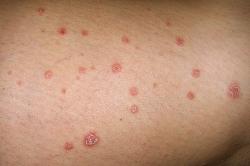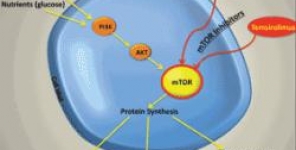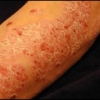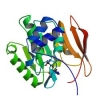L'1α,25-diidrossivitamina-D3-3-bromoacetato regola la via di segnalazione AKT/mTOR: un agente terapeutico per la psoriasi
 L'efficacia dell'1α,25- diidrossivitamina D3 (Vit-D) ne limita l'uso topico nonostante i suoi profondi effetti sulla differenziazione, proliferazione e immunomodulazione cellulare. Pertanto, essendo alla ricerca di un analogo della Vit-D più efficace, con questo studio abbiamo voluto valutare gli effetti antiproliferativi e pro-apoptotici dell'1α,25- diidrossivitamina-D3-3- bromoacetato (BE).
L'efficacia dell'1α,25- diidrossivitamina D3 (Vit-D) ne limita l'uso topico nonostante i suoi profondi effetti sulla differenziazione, proliferazione e immunomodulazione cellulare. Pertanto, essendo alla ricerca di un analogo della Vit-D più efficace, con questo studio abbiamo voluto valutare gli effetti antiproliferativi e pro-apoptotici dell'1α,25- diidrossivitamina-D3-3- bromoacetato (BE).
Sono stati condotti degli studi sulla proliferazione e sull'apoptosi dei cheratinociti epidermici umani (NHEKs) impiegando MTT (3 — (4,5-dimetiltiazolo-2-il) -2,5-difeniltetrazolo bromuro), la diluizione CFSE (carbossi-fluoresceina- diacetato succinimidil estere), e il saggio dell'annessina V; inoltre, sono stati eseguiti il Western blot e la real-time PCR per determinare gli effetti sulla trasduzione del segnale. È stato usato un modello di epidermide umana ricostituita (RHE) con lo scopo di validare ulteriormente il ruolo terapeutico di BE nella psoriasi.
BE è stata significativamente più potente rispetto ad una pari concentrazione di Vit-D nell'inibire la crescita e la sopravvivenza dei cheratinociti umani. È stato scoperto che l'effetto antimitotico era dovuto all'inibizione della fosforilazione della serina/treonina protein chinasi (AKT) e del suo bersaglio a valle, il bersaglio della rapamicina nei mammiferi (mTOR). Nel modello di RHE, BE ha invertito i cambiamenti psoriasiformi indotti dall'IL-22 in un modo più efficace rispetto alla Vit-D.
È interessante notare come BE abbia inibito l'espressione genica, indotta dall'IL-22, di AKT1, di mTOR, delle chemochine [IL-8 e RANTES (regolata su attivazione, espressa e secreta dalle normali cellule T)], e della psoriasina (S100A7) più efficacemente rispetto alla Vit-D. Questi risultati, quindi, mostrano l'enorme potenziale di BE come agente terapeutico per la psoriasi.
Storia della pubblicazione:
Titolo: 1α,25-Dihydroxyvitamin-D3-3- Bromoacetate Regulates AKT/mTOR Signaling Cascades: A Therapeutic Agent for Psoriasis
Rivista: Journal of Investigative Dermatology (11 January 2013) | doi:10.1038/jid.2013.3
Autori: Ananya Datta Mitra, Siba P Raychaudhuri, Christine J Abria, Anupam Mitra, Rebecca Wright, Rahul Ray e Smriti Kundu-Raychaudhuri
Affiliazioni:
Abstract:
The efficacy of 1α,25- dihydroxyvitamin D3 (Vit-D) limits its topical use despite its profound effects on cellular differentiation, proliferation, and immunomodulation. Therefore, in search for a more effective analog of Vit-D, in this study we have evaluated the antiproliferative and proapoptotic effects of 1α,25- dihydroxyvitamin D3-3- bromoacetate (BE). Proliferation and apoptosis studies in normal human epidermal keratinocytes (NHEKs) were conducted by MTT (3-(4,5-dimethylthiazol-2- yl)-2,5-diphenyltetrazolium bromide), CFSE (carboxy fluorescein succinimidyl ester) dilution, and Annexin V assays. Western blot analysis and real-time PCR were performed to determine its effect on signal transduction. A reconstructed human epidermis (RHE) model was used to further validate the therapeutic role of BE in psoriasis. BE was significantly more potent than an equivalent concentration of Vit-D in inhibiting growth and survival of human keratinocytes. The antimitotic effect was found to be due to the inhibition of phosphorylation of serine/threonine protein kinase (AKT) and its downstream target, mammalian target of rapamycin (mTOR). In the RHE model, BE reversed IL- 22-induced psoriasiform changes more effectively than Vit-D. Interestingly, BE inhibited the IL-22-induced gene expression of AKT1, MTOR, chemokines [IL-8 and RANTES (regulated upon activation, normal T-cell expressed and secreted)], and psoriasin (S100A7) more significantly than Vit-D. These results suggest the potential of BE as a prospective therapeutic agent for psoriasis.




